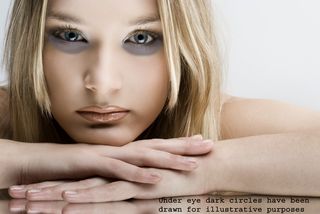Get Rid of Those Pesky Dark Circles Under Your Eyes

Dark circles under the eyes plague many of us. There are many reasons for the dark circles, including allergies, hormonal changes or imbalances, shadowing from “puffy” lower eyelid bags, and prominent veins or capillaries, but often the discoloration has to do with the thin skin overlying the muscles and blood vessels around the eyes. Because the skin is so thin, a purplish color can show through representing the muscle and soft tissues below the skin. Making the skin thicker in this area can be difficult and may require the guidance of a facial plastic surgeon, but covering dark areas up doesn’t have to be difficult for those of us who wear make-up. The essential idea behind using make-up to disguise discoloration is the fact that opposite colors cancels each other out, leaving a more natural skin color.
 Following the color wheel, if you have dark purple circles under your eyes, you should use its opposite color–which is yellow. If your under eye is dark blue, then you should use orange based concealer.
Following the color wheel, if you have dark purple circles under your eyes, you should use its opposite color–which is yellow. If your under eye is dark blue, then you should use orange based concealer.
Choose a shade that is lighter than your skin color for best results. However, if you have puffy bags under your eyes like I do, you should select something a little darker. The reason is because light colors will accentuate your features and make your bags more prominent. This is why makeup artists use white or light shimmer colors to highlight the cheekbones and the nose.
 One brand I can personally recommend using is Physicians Formula Mineral Wear corrective cream concealer. It’s effective but inexpensive, and you can easily find it at CVS or other local drug stores. It comes in three different colors depending on your individual needs.
One brand I can personally recommend using is Physicians Formula Mineral Wear corrective cream concealer. It’s effective but inexpensive, and you can easily find it at CVS or other local drug stores. It comes in three different colors depending on your individual needs.
With your ring finger, dab a tiny amount of concealer across your undereye. Starting from the outer corner of your eye, gently pat it down towards the inner corner, then reverse the process and pat it towards the middle of your lower eyelid until it has been absorbed. Apply more if you have very dark circles. But don’t overdo it. In this case, less is more. Proceed to use your regular foundation and finish up by pressing powder against your skin as usual. Remember to be gentle—the skin under your eyes is thin and delicate! You can also try mica powder, a very fine powder that shimmers in the light. This can reflect light off of your skin, creating an illusion that hides your dark circles. But again, this will only work for someone without puffy under eyes.
If you are someone who doesn’t want to apply makeup every day, you might consider self tanners. Tanning will create a tone around your eyes closer to the shade of your dark circles, thus making it a lot less noticeable. I use Jergen’s Natural Glow. It is easy to use and works like a daily moisturizer. This is a gradual tanner and depending on your natural skin color, it may take several days to get to the shade you desire. Remember that Dr. Chow does not recommend actual tanning, whether out in the sun or at the salon! Excessive UV radiation damages and ages your skin, increasing the risks of irregular pigmentation, wrinkles, and cancer, among other things.
Unfortunately, make up and self tanners are only a temporary, stop-gap solution for dark circles under the eyes. To get rid of those heavy dark circles and (and eye bags!) for good, visit your facial plastic surgeon for suggestions tailored just for you. This can make all the difference! Future entries will focus on some of the medical and surgical options available to you for more definitive treatment of dark lines.
Annie Lee is an aesthetic consultant at the Chow Center for Facial Plastic Surgery. Her blog entries appear weekly on Monday mornings and focus on treatments you can do at home. She has no financial relationships with any of the products or companies mentioned in this article.

